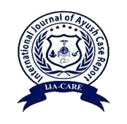A Study on Effect of Cyclic Meditation on Heart Rate Variability in Young Healthy Adults
Abstract
Yoga is an ancient Indian practice that combines physical and mental activities to achieve mental and bodily calm which leads to a state of relaxation beneficial for stress and anxiety management. Cyclic meditation which is named as moving meditation taken from the Mandukiya upanishad is a hybrid of yoga postures and guided meditation which includes instant, quick and deep relaxation techniques. The aim of trial was to study the effect of cyclic mediation on Heart rate variability in Young healthy adults. This is an interventional study which includes young adults of both gender in the age group of 20-30 years selected from JSS Medical college. The study was done after obtaining ethical clearance from the ethical committee of JSS Medical college, Mysuru. Screening of 100 subjects were done and among them 34 were selected. The subjects were briefed about the purpose of study and protocol was explained. Informed consent was taken from all of them. HRV and BP were measured before and after CM in each of them. The collected data was entered into MS Excel followed by the analysis using SPSS version 22. The comparison of HRV and BP before and after cyclic meditation were done using paired sample t test. A P value of <0.05 was considered statistically significant. Average HR is decreased after the practice of CM in the participants (81 vs 77). The LF/HF ratio decreased (0.15 to 0.12), pNN50 increased (9.28 to 29.46), TP (--) increased after the intervention. Comparison of blood pressure showed that both SBP (116 to 106) and DBP( 76 to 69) decreased after the practice of CM. The results of the study, shows that CM session is associated with increased parasympathetic activity and a corresponding shift in sympathovagal balance as reflected in LF /HF ratio. Hence CM is one of the best alternative for stress relieving.

This work is licensed under a Creative Commons Attribution-NonCommercial-NoDerivatives 4.0 International License.

